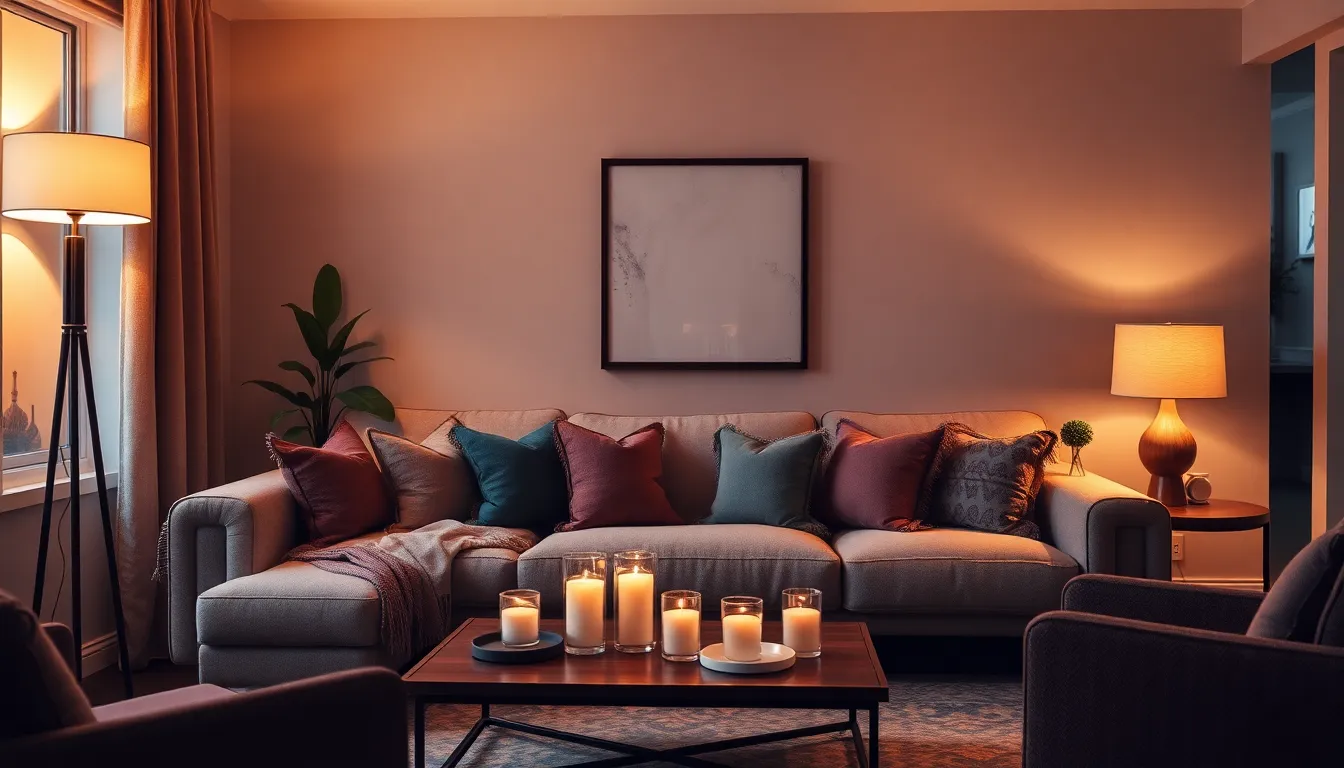Imagine walking into a room that feels like a warm hug after a long day. Mood lighting at home isn’t just about flicking a switch; it’s about setting the stage for your life’s little moments. Whether it’s a cozy movie night or a romantic dinner, the right lighting can transform an ordinary space into an extraordinary experience.
Table of Contents
ToggleUnderstanding Mood Lighting At Home
Mood lighting plays a crucial role in establishing a warm and inviting atmosphere. It affects both emotions and behaviors, making spaces feel comfortable and personal.
Definition and Importance
Mood lighting refers to lighting specifically designed to enhance a particular emotion or ambiance in a space. Soft, diffused light creates a relaxing environment. Bright, focused light may increase alertness and energy. Thoughtful use of various light sources contributes to the overall aesthetic and functionality of a home. Defining personal spaces with intentional lighting choices helps individuals express their style while promoting well-being.
Benefits of Mood Lighting
Mood lighting offers numerous advantages for home environments. It can enhance relaxation during evenings, making unwinding easier after a long day. During gatherings, well-placed lighting encourages social interaction and fosters a sense of intimacy. The right lighting can influence productivity, particularly when working from home. Additionally, mood lighting contributes to the overall design theme of a room, creating harmony among furnishings and décor. Homeowners often find that adjustable lighting options enhance versatility, accommodating different activities and moods.
Types of Mood Lighting

Different types of mood lighting serve various purposes in a home environment. They each contribute uniquely to creating an inviting atmosphere.
Ambient Lighting
Ambient lighting provides overall illumination for a space. This type of lighting often originates from ceiling fixtures or wall-mounted lamps. It fills the room with a soft glow, helping to establish a relaxed atmosphere. Dimming options can enhance this effect, allowing residents to adjust brightness based on activities or time of day. Popular sources include recessed lighting and chandeliers, which create depth and warmth.
Task Lighting
Task lighting concentrates light on specific areas for activities requiring focus. This type of lighting assists with reading, cooking, or other precise tasks. Desk lamps and under-cabinet lights are practical examples that enhance visibility while reducing eye strain. Positioning task lights strategically minimizes shadows and promotes productivity. Adjustable features allow users to change the intensity and angle to suit their needs.
Accent Lighting
Accent lighting highlights specific objects or areas in a room. This type emphasizes artwork, architectural features, or decorative elements to create visual interest. Spotlights and wall sconces are common choices for achieving effective accent lighting. By drawing attention to focal points, it enhances the room’s ambiance. Layering accent lighting with other types provides a more dynamic and personalized design.
How to Create Mood Lighting At Home
Creating mood lighting at home involves thoughtful choices about bulbs and controls. Adjusting light sources enhances the ambiance of any room.
Choosing the Right Light Bulbs
Selecting the appropriate light bulbs plays a vital role in achieving mood lighting. Warm white bulbs with a color temperature between 2700K and 3000K produce a cozy atmosphere. Soft white LED bulbs provide energy efficiency while delivering the desired warmth. Incorporate dimmable bulbs for added versatility, allowing adjustments based on activities. Additionally, colored bulbs can set a specific mood during gatherings or celebrations. Prioritizing the right brightness ensures comfort and promotes relaxation in various spaces. Choosing the right bulb enhances not only lighting but the entire environment.
Utilizing Dimmers and Smart Controls
Implementing dimmers can transform the lighting experience instantly. Dimmers allow easy adjustments to light intensity, accommodating different moods and occasions. Smart controls offer convenience, enabling users to adjust lighting remotely through smartphones or voice commands. Many systems also permit scheduling, so lights transition automatically throughout the day. Combining dimmers with smart controls enhances flexibility, making it easier to create a desired atmosphere. Coordinating these technologies fosters a functional yet inviting space, ideal for relaxing or entertaining.
Decor Tips for Mood Lighting
Creating the right atmosphere involves thoughtful decor choices. Homeowners can enhance mood lighting through specific techniques, focusing on color schemes and the selection of light sources.
Color Schemes and Light Filters
Warm colors like soft reds, oranges, and yellows promote comfort and coziness. Using colored light filters can also adjust the intensity and hue of illumination to match the desired aesthetic. Selecting light bulbs with a color temperature between 2700K and 3000K fosters a welcoming ambiance. Effective use of diffusers can soften harsh light, creating an inviting glow. Incorporating complementary colors in furnishings and decor emphasizes the overall lighting effect. Attention to balance in colors ensures the space feels harmonious and serene.
Layering Light Sources
Layering different light sources adds depth to the overall design. Combining ambient, task, and accent lighting creates a versatile environment. Ceiling fixtures provide general illumination, while floor lamps offer localized lighting for activities. Adding table lamps enhances spaces with softer light, making them suitable for relaxation. Integrating wall sconces can highlight artwork or architectural features, enhancing visual complexity. Adjustable fixtures allow homeowners to change intensity based on their needs, ensuring spaces remain inviting for gatherings or quiet moments.
Mood lighting significantly transforms a home’s atmosphere. By thoughtfully combining ambient, task, and accent lighting, individuals can create spaces that cater to various activities and emotions. The right lighting not only enhances comfort but also influences how people interact and feel within their environment.
Adjusting light intensity and color can elevate everyday moments into memorable experiences. By incorporating smart controls and dimmable options, homeowners gain the flexibility to adapt their lighting to any occasion. Ultimately, embracing mood lighting leads to a more inviting and personalized home that reflects individual tastes and enhances daily life.








